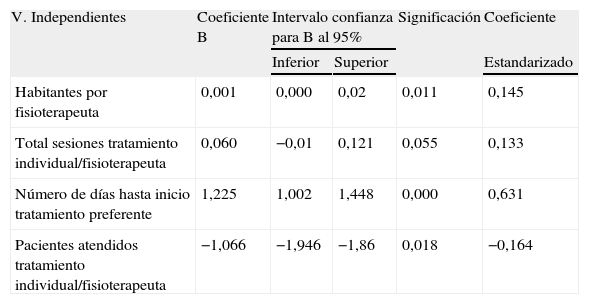La puesta en marcha del Plan de Apoyo de las Familias Andaluzas (Decreto 137/2002) ha supuesto una reforma bastante positiva para la fisioterapia de atención primaria (AP) en Andalucía, si bien esta ha sido lenta, irregular, con recursos insuficientes y poco homogéneos.
ObjetivosConocer la variabilidad de las ratios «fisioterapeuta de AP por habitantes» en todas las salas de Andalucía, observar su influencia en los indicadores asistenciales de los que se dispone y hallar los factores de riesgo que afectan a los tiempos de espera para el inicio del tratamiento fisioterápico.
Material y métodosEstudio observacional descriptivo ecológico. Periodo de estudio: primer semestre de 2008. Fuente de información: Sistema de Información para la Gestión de AP. El análisis estadístico realizado se ha valorado de acuerdo a los criterios psicométricos de escalas numéricas. Se ha utilizado análisis bivariante, regresión lineal, regresión logística y análisis multivariante.
ResultadosExiste una gran variabilidad de ratio fisioterapeuta de AP por habitantes en las salas de fisioterapia de Andalucía. Se ha obtenido una ecuación que calcula la probabilidad de demora en días para el inicio de tratamiento fisioterápico de un paciente con derivación normal que depende, especialmente, de la cantidad de población asignada al fisioterapeuta de AP y de la demora que provoca la derivación de pacientes preferentes. Habiendo comprobado la relación que existe entre estas variables, parece conveniente y prioritario el incremento de los recursos humanos en las salas con ratios elevadas.
The setting up of the ‘Supportive Plan for Andalusian Families’ (Decree 137/2002) has resulted in a very positive reform for the Andalusian Primary Health Care Physiotherapy, even though it has been slow and irregular, with deficient and not very homogeneous resources.
ObjectivesTo know the variability for Primary Health Care physiotherapist/inhabitant ratio in all of the Andalusian rooms, to observe its influence on all the available care indicators, and to find the risk factors that may affect the waiting times to initiation of physiotherapy treatment.
Material and methodsEcological, descriptive, observational study. Study period: first half of 2008 (January to June). Information source: Information System for Primary Health Care Management. The statistical analysis performed was carried out in accordance with psychometric criteria of numerical scales. Bivariate analysis, linear regression, logistic regression and multivariate analysis were used.
ResultsThere is high variability in the Primary Health Care physiotherapist/inhabitant ratio in Andalusian physiotherapy rooms. An equation has been obtained for the calculation of the ‘days of delay probability’ until the initiation of physiotherapy for a normal-referred patient. The research shows how this probability of delay depends mainly on the total population assigned to each Primary Health Care physiotherapist, and on the delay caused by priority-referred patients. Having confirmed the relationship between these variables, increasing the human resources in those rooms with higher ratios seems to be an advisable and high priority action.
Artículo
Si ya tiene sus datos de acceso, clique aquí.
Si olvidó su clave de acceso puede recuperarla clicando aquí y seleccionando la opción "He olvidado mi contraseña".Comprando el artículo el PDF del mismo podrá ser descargado
Precio 19,34 €
Comprar ahora













